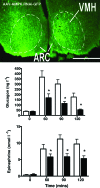Bringing light to the dark side of insulin: a journey across the blood-brain barrier
- PMID: 18753671
- PMCID: PMC2518475
- DOI: 10.2337/db08-9023
Bringing light to the dark side of insulin: a journey across the blood-brain barrier
Figures











References
-
- Saccà L, Hendler R, Sherwin RS: Hyperglycemia inhibits glucose production in man independent of changes in glucoregulatory hormones. J Clin Endocrinol Metab 47 :1160 –1163,1978 - PubMed
-
- Tamborlane WV, Sherwin RS, Genel M, Felig P: Reduction to normal of plasma glucose in juvenile diabetes by subcutaneous administration of insulin with a portable infusionpump. N Engl J Med 300 :573 –578,1979 - PubMed
-
- Tamborlane WV, Sherwin RS, Genel M, Felig P: Restoration of normal lipid and amino acid metabolism in diabetic patients treated with a portable insulin pump. Lancet 1 :1258 –1261,1979 - PubMed
-
- Tamborlane WV, Hintz R, Bergman M, Genel M, Felig P, Sherwin RS: Insulin infusion pump treatment of diabetes: influence of improved metabolic control on plasma somatomedin levels. N Engl J Med 305 :303 –307,1981 - PubMed
Publication types
MeSH terms
Substances
Grants and funding
LinkOut - more resources
Full Text Sources
Medical

